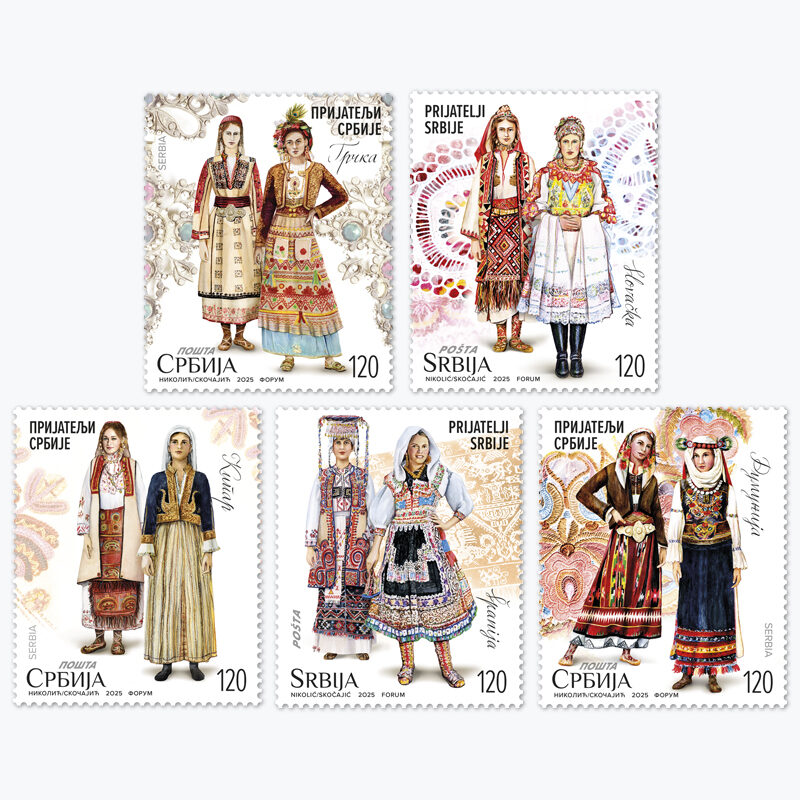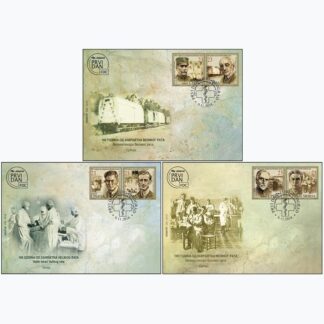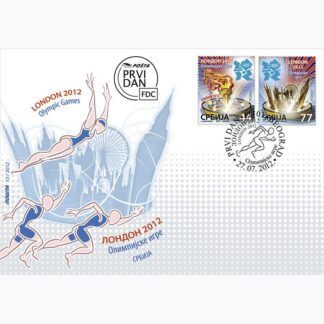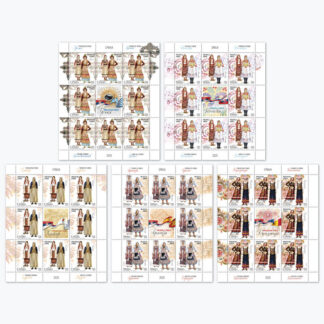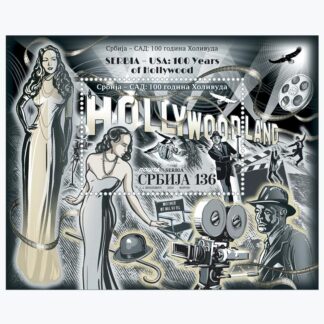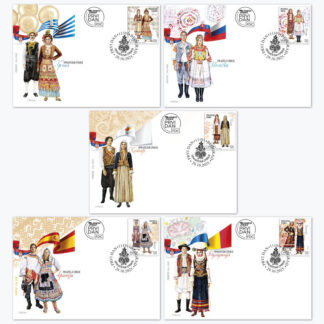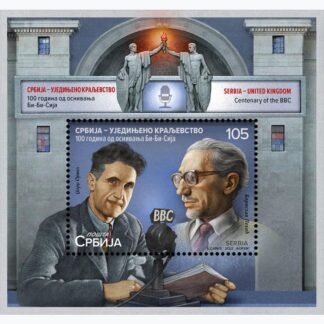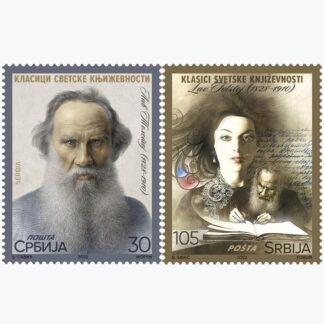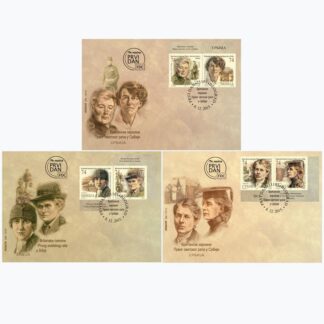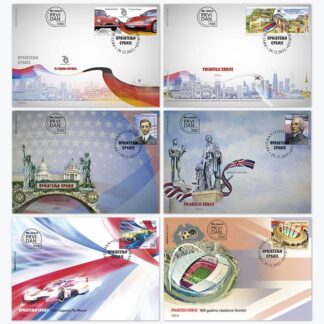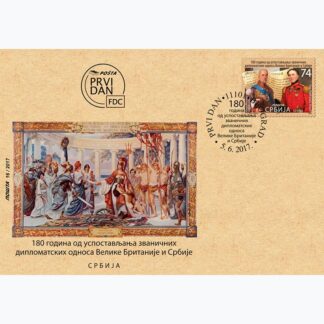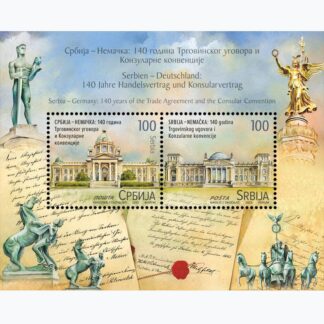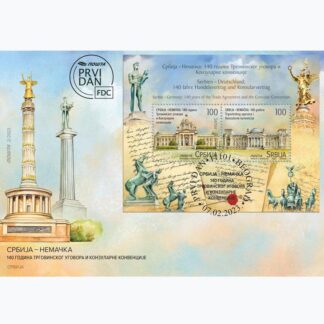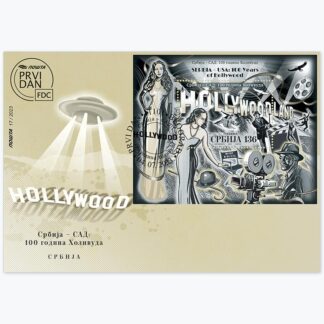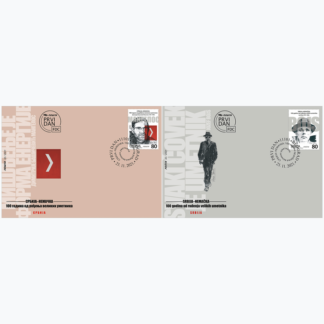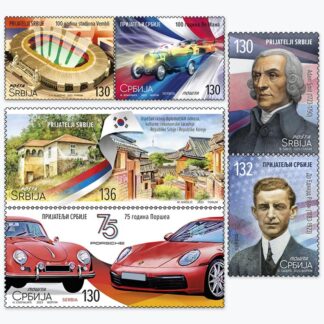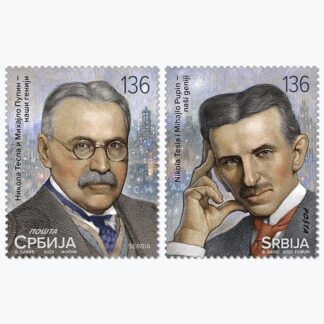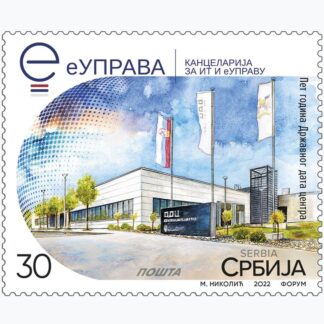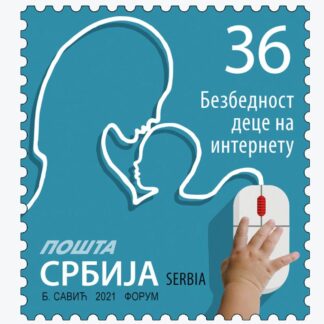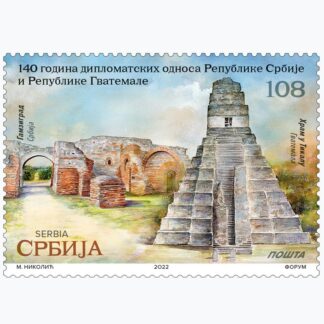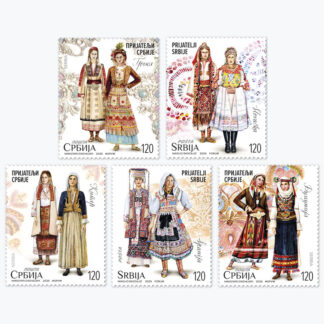Description
FRIENDS OF SERBIA
With this commemorative stamp issue, we show our respect and gratitude to the countries of Europe with which Serbia fosters deep friendly relations based on mutual trust and support. The motifs on the stamps depict an example of the rich cultural and historical heritage of our own and our friendly nations, depicted in folk attire that testify to the preservation of tradition and underline the closeness that connects and unites us with our friends.
Friends of Serbia – GREECE
Women’s costume from Corfu, Ionian Islands, early 20th century
The bridal and festive costume of Corfu includes as undergarments a white bodice and the “rokéto” a fine calico petticoat. The skirt, “velesi” or “ambito”, is made of blue taffeta with gold embroidery on the hem. The bosom is covered with the “boustína” (a white dickey), and the waist is tightened with the “chrysózoni” or “chrysokímero” (gold belt), over which a short sleeveless waistcoat, “zipouni”, is worn, which is fastened with “fioúmbes” (gold cufflinks). The outer sleeved jacket (the ”pesselí” or “krémezo”) is made of garnet-red velvet adorned with gold embroidery. The bridal apron is made of white tulle and is completely embroidered with multi-coloured wool, and decorated with small bows and rosettes made of coloured ribbons. The headdress (“yiádema” or “stólos”) is worn for the first time by a girl on her wedding day after which she continues to wear it throughout her life. The old hairstyle has been replaced by the “torkós”, which is formed from four long black coils of hair (“boumbária”) bound with red ribbons (“staftádes”). It is adorned with flowers, mirrors, thin metal spirals, feathers, peacock feathers and a starched “ bólia” (a type of veil). The earrings are “verges” and “kambánes”, and round the neck is a chain fastened to a filigree brooch on the bosom called the ílios (sun). She has three more gold brooches of different sizes and a gold cross with a crown.
Collection of the Basil Papantoniou Foundation, Nafplion.
Female folk attire, Vlasina, southeastern Serbia, 19th century
So-called “Shopi attire” are widespread in the regions of southeastern Serbia, and its content and appearance show significant individuality in the overall corpus of Serbian folk attires. Certain elements of the attire intended for the bride, such as a long, uncut, sleeveless dress, “manovil”, a shirt “alenica” and a cap “kaica”, of specific craftsmanship and predominantly red in colour, with their archaic, Old Slavic origin, still attract the attention of museum experts and ethnologists today.
Professional cooperation on the issue: Embassy of Greece in Belgrade; Basil Papantoniou Foundation, Nafplion Greece – Angeliki Roumelioti, Head of Collection Department.
Friends of Serbia – SLOVAKIA
Bridal attire from Krakovany, Trnava region, Slovak Republic, first half of the 20th century
Krakovany belongs to the Trnava region and is a typical representative of the traditional clothing of western Slovakia. What is characteristic of traditional folk attire from Krakovany is that it is very richly decorated with various types of embroidery, using yellow-orange, red, yellow and gold thread. The decoration of female clothing is dominated by bobbin lace (spools) with geometric patterns, which in 2022 was entered on the Representative List of Intangible Cultural Heritage of Slovakia.
The traditional folk attire shown on the issue is the property of Daniela Piscova.
Female attire, Raška
Serbian female attire from the Raška region was made mainly of wool and hemp cloth (rarely of cotton and linen) and dyed with natural vegetable dyes. It consisted of an embroidered hemp shirt and a woollen skirt, with a colourful woollen apron over which the woven belt was tied. Over everything, a “zubun” was worn – one of the oldest pieces of clothing in the southern Balkans, sleeveless, cut in front, length from mid-thigh to below the knee. It is made mostly of white rolled woollen cloth and lavishly decorated with colourful embroidery with wool cords and thread. Geometric and stylized plant ornamentation was most commonly used.
All pieces of clothing were made and decorated by hand, using local craftsmanship.
Professional cooperation on the issue: Embassy of the Slovak Republic in Belgrade, Slovak Intangible Heritage Centre of Slovak State Traditional Dance Company (SĽUK), state-funded organization established by the Ministry of Culture of the Slovak Republic.
Friends of Serbia – CYPRUS
Traditional attire from Cyprus
Cypriot folk attire is characterized by simplicity and relative uniformity, with regional variations in ornamentation, the combination of individual garments, and the use of colour. The four traditional types of attire – urban, mountain, Karpasia, and Paphos – were made of wool, linen, cotton, or silk, often hand-woven, and enriched with embroidery or printed patterns.
Female clothing usually consisted of an inner and outer headscarf, a cotton shirt with wide sleeves, over which a long “sagia” of woven cotton was worn; open in front, with slits on the sides and narrow black sleeves. Over the “sagia”, women wore a white cotton tunic (“tupletti”) or a short cloak with wide sleeves (“sarka”). Footwear consisted of leather knee-high boots (“podines”) with heels, or low flat shoes. The attire was completed by an embroidered belt on the hips and jewellery that decorated the chest, neck and arms.
Female attire, Niš area, Serbia, 19th century
Female attire from the Niš area was created in the mid-19th century, with still visible influences from the clothing styles of the upper social classes of medieval Serbia. With the numerous migration movements of the Serbian people towards the northern and western regions, this type of attire spread and adapted to different local traditions and ways of making clothing ensembles. The main elements are as follows: a long open dress, “zubun” or “ćurdija”, a large presence of gold thread in the decoration, such as on the apron “pregača” and a specific headdress “ručnik” over a specially curled hairstyle “trvelji”, which gives this attire unique artistic quality in the context of Serbian history and culture.
Professional cooperation on the issue: Embassy of the Republic of Cyprus in Belgrade; Charalampos Chotzakoglou, PhD, Cyprus Folk Art Museum of the Society of Cypriot Studies.
Friends of Serbia – SPAIN
Bridal attire, Lagartera, Province of Toledo, Castilla–La Mancha, 16th –17th century
In the heart of Castilla–La Mancha, one of the most impressive and complex items of clothing has been preserved – the bridal attire, which is associated with the story of centuries of embroidery, made with patience, dedication and high artistic and symbolic value. This attire comes from the 16th and 17th centuries, when Lagartera was already known for its textile industry. Over time, this incredibly rich embroidery became an element of collective identity, surviving to this day as a cultural symbol that can be seen at festivals, in museums, in the press and in photographic records.
Bridal attire with a plumed cap, Raška, southwestern Serbia, 19th century
The rich bridal clothing consisted of a long linen shirt, a waistcoat, a woollen sleeveless dress “zubun”, a woven woollen apron, and a belt. All pieces of clothing were made and decorated by hand, from local materials, using local craftsmanship. The most impressive element of the bride’s attire is the cap, which had a strong symbolic role because, according to belief, it protected the bride from evil forces and curses. It was richly decorated with beads, bells, buttons, mirrors, horse hair accessories. It was believed that the bride is most vulnerable on her wedding day, so by wearing a hat that made a sound when the bride moved, demons were chased away. This kind of headpiece was worn by the bride not only on her wedding day, but also later, until the birth of her first child.
Professional cooperation on the issue: Embassy of Spain in Belgrade.
Friends of Serbia – ROMANIA
Traditional folk attire from the Bistrița area, Romania
The folk attire from the Bistrița area clearly differs from the attire in neighbouring areas, both in terms of elements and in how it changed over time, with each community having a well-defined dress code, in accordance with social and marital status.
The bride from Bistrița wears colourful attire with various decorations, consisting of a shirt made of handmade textile, decorated above the elbow with embroidery of colourful glass beads, with pleats around the neck.
Male folk attire consists of a plain shirt, sewn from handmade cotton fabric, decorated around the collar, front and sleeves with embroidery made of multi-coloured beads with plant motifs.
Female folk attire with a woollen robe and silver buckles, Vranjska Pčinja, southern Serbia, late 19tth century
Specific forms of certain clothing elements such as the open-type skirt, the so-called “futa” and the extensive use of brown woollen cloth “klašnja”, as a reflection of the economic activity, predominantly livestock farming in these regions, are characteristic elements of the Serbian folk attire of the Central Balkan type. We find them in two different variants, depending on the length and openness in the front, from Kosovo and Metohija, Macedonia, Pomoravlje, through Resava and Svrljig all the way to the Timok regions in northeastern Serbia.
Professional cooperation on the issue: dr. Virgil Ștefan Nițulescu – manager of the National Museum of the Romanian Peasant; Embassy of the Republic of Romania in Belgrade, Vlad Nicoară.
Professional cooperation on the entire issue (motifs from Serbia): Ethnographic Museum, Belgrade, Tatjana Mikulić, PhD, Museum Advisor; Vjera Medić, Museum Advisor, Ivan Maksimović, Curator. Vuk Nenezić, Photographer.
Artistic realization of the issue: Miroslav Nikolić, MA Nadežda Skočajić, Academic Graphic Artist.
